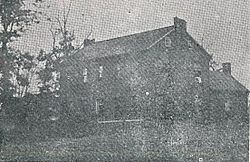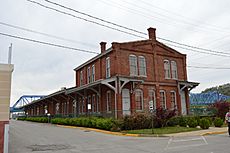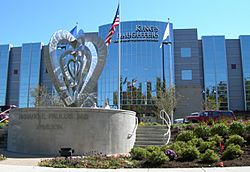History of Ashland, Kentucky facts for kids
Ashland is a city located in northeastern Kentucky. For a very long time, different Native American groups lived here. These included the Adena culture, Hopewell culture, Armstrong culture, and Fort Ancient peoples. Later, the Shawnee tribe also called this area home.
European settlers, many of whom were from Scotland and Ireland, started arriving in 1783. In 1800, people found lots of iron in Ashland. This discovery brought many new industries to the city over the next 200 years. Today, Ashland continues to grow. Its economy has changed from mostly factories to more service-based jobs.
Contents
Ashland's Ancient Past

Long before Europeans arrived, Native Americans lived in the area that is now Ashland. They had moved southeast from Beringia, a land bridge that once connected Asia and North America.
During a time called the Woodland period, the Adena culture built large earthworks. These are like big mounds made of earth. One important site is the Biggs site in South Shore. It dates back to about 800 BC to 0 AD.
Later, the Hopewell culture expanded these earthworks. They created the huge Portsmouth Earthworks from about 0 AD to 500 AD. Ashland is located between the Hopewell and the Armstrong culture, who lived along the Big Sandy River.
Ashland's Central Park has six ancient burial mounds. These mounds are about 4 to 5 feet tall. They are listed on the National Register of Historic Places. Experts believe they are from the Adena period. Many other mounds in the city were removed when Ashland was built. The ones in Central Park are actually restored versions of smaller mounds.
Around 1000 AD, the Fort Ancient culture followed the Hopewell and Armstrong peoples. The group closest to Ashland was called the Feurt Focus. This group later developed into the Shawnee tribe. A large Shawnee community called Lower Shawneetown was located near South Portsmouth.
How Ashland Began
Poage Settlement: The First Homes
Ashland was first known as "Poage Settlement" or "Poage's Landing." The Poage family from Virginia were among the first settlers. Robert Poage and his sons, along with Major George Poage and his son, owned thousands of acres of land. The first official land grant in the area was given to General James Wilkinson in 1783. Robert Poage bought a large part of this land.
The Poage family had roots in Scotland and Ireland. Some came to Kentucky from Virginia through the Cumberland Gap in 1786. Others came from Virginia through Harrodsburg and Mayslick. They settled on farmlands along the Ohio River. They also ran a sawmill powered by water near Hoods Creek, possibly as early as 1799. The Poage settlement was a family-based community until the mid-1800s.
Iron Discovery and Growth
In 1800, a farmer named Richard Deering made an important discovery. He found high-quality iron ore on his land near the Little Sandy River. This discovery greatly changed the area's future.
In 1815, Deering built a small furnace to make farm tools. His business grew, and in 1818, he built Argillite Furnace with David and John Trimble. This was the start of the iron industry in northeastern Kentucky.
More furnaces were built, and iron from the Hanging Rock Iron Region became famous. This iron was known for its high quality. Iron made at these furnaces was taken to Poage's Landing and Hanging Rock, Ohio. From there, it was shipped on the Ohio River to cities like Pittsburgh and Cincinnati.
Naming the City: Ashland
Poage's Landing quickly became an important industrial center. The first post office opened in 1847 at Pollards Mill. Seven years later, it was renamed "Ashland." In 1854, the Kentucky Iron, Coal and Manufacturing Company was formed. This company started the industrial growth.
The company hired an engineer named Martin Toby Hilton to design the new town. He laid out wide streets, which was unusual at the time. The town was named "Ashland" after Henry Clay's famous estate in Lexington.
In 1854, Levi Hampton, one of the company's founders, suggested the name "Ashland." He admired Henry Clay and his estate, Ashland. The name change was accepted by everyone. Land lots were sold in June 1854. The City of Ashland officially became a city in 1856. Boyd County was created in 1860, mostly from Greenup County. The first child born in the new city was named Ashland Poage.
Ashland's Industrial Boom
In the first half of the 1900s, several large companies provided many jobs in Ashland. These included Armco, Ashland Oil and Refining Company, the C&O Railroad, and Allied Chemical and Dye Corporation.
Armco Steel Mill
A major industrial project began in Ashland in 1920. George M. Verity, president of Armco, planned to build a large steel mill. When it opened in 1923, it was special. It used a new method to make steel sheets, the first of its kind in the country. Armco later bought other local iron companies.
Armco provided many jobs. In 1920, it employed 3,600 people. By 1954, that number grew to 7,500. However, over time, the number of jobs at Armco decreased. By 1992, only about 700 people worked there.
In 1925, the Ashland Culvert Works company was started. Armco later bought it and renamed it. In 1941, construction began on the Bellefonte Furnace. It cost $5 million and could produce 1,000 tons of steel every day.
In the 1950s, Armco expanded its operations. A new hot-strip mill opened in 1953, creating 3,000 jobs. More mills were added, costing millions of dollars. In the late 1950s, Armco announced a huge $145 million upgrade. As part of this, the Amanda blast furnace was completed in 1963.
In the 1980s, Armco tried to become more efficient. This led to some job losses. The hot strip mill closed in 1992, eliminating 930 jobs. Other parts of the plant also closed by 1995. In 1989, Armco sold part of its company to Kawasaki Steel of Japan. By 1994, the plant was fully sold and renamed AK Steel.
By becoming more efficient, the plant started making more money. The number of workers increased to 900 by 2004. In 2004, the governor announced a $40 million tax break. This helped fund upgrades to the plant, making it easier to produce steel for cars.
Allied Chemical & Dye Company
A coke plant was built in Ashland in 1912. It had 54 coke ovens, which are used to make coke from coal. Four years later, another 54 ovens were added. In 1937, the original ovens were expanded.
In 1953, the plant expanded again with a third set of ovens. This increased the plant's capacity and created more jobs. A research laboratory was also built in the early 1950s. This plant is now closed.
Ashland Oil and Refining Company
The Ashland Oil and Refining Company started in 1924. It bought a small refinery near Catlettsburg. This refinery could process 1,000 barrels of oil a day. Its first product was "Pepper" gasoline, which was later renamed "Ashland" gasoline.
Dealing with Floods
After a big flood in 1937, people started talking about building a floodwall. Construction on the floodwall began in July 1949. It was finished in December 1953. The floodwall cost about $3.872 million to build.
Ashland Today
Ashland has grown beyond its official city limits. This means that while the city's population count might seem lower, many people live in the surrounding areas. Ashland has two zip codes, 41101 and 41102. The 41102 zip code covers parts of the city and the nearby areas. Together, these two zip codes have about 40,000 residents, which gives a better idea of Ashland's community size.
In the past, there were ideas to combine the governments of Boyd County, Ashland, and Catlettsburg. These ideas did not pass, but they led to more cooperation between the cities. For example, sewer lines were extended into areas outside the city. This helped new businesses and homes grow along the US 60 shopping area.
The big factories that once supported Ashland have changed. Companies like Armco (now AK Steel) reduced their workers to stay competitive. Many jobs were given to local contractors. The Bellefonte Furnace at the steel plant was closed, and the hot strip mill stopped operating.
CSX, which used to be the Chesapeake and Ohio Railway, runs one of the world's largest train yards nearby. In 1997, an old train freight house was turned into the Ashland Transportation Center. This center is a hub for passenger services like Amtrak, Greyhound Lines, and the Ashland Bus System.
Today, the service industry has taken the place of manufacturing. King's Daughters Medical Center has grown a lot. It is now the largest employer in the region, providing many healthcare jobs. Even though the city's official population has decreased, this is mainly because new businesses have replaced homes, and the city hasn't officially added new growing areas.
On October 4, 1989, the Ashland Town Center mall opened. It had stores like Wal-Mart, Hess's, and J.C. Penney, plus many smaller shops and a food court. The mall was about 500,000 square feet. It eventually had 87 stores and restaurants. A few months later, another mall, the Cedar Knoll Galleria, opened. Over time, Ashland Town Center became more successful, while Cedar Knoll Galleria struggled. In 2004, Cedar Knoll Galleria was bought by new owners and renamed Kyova Mall.





